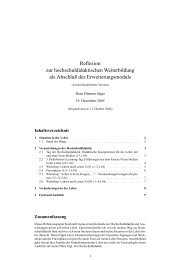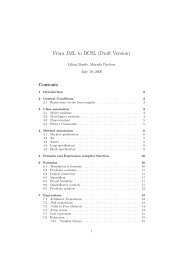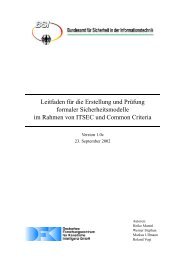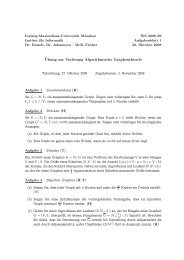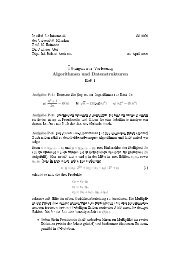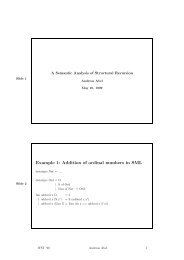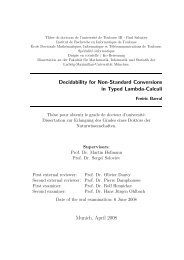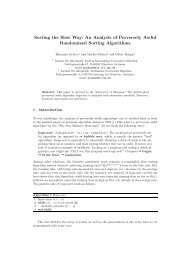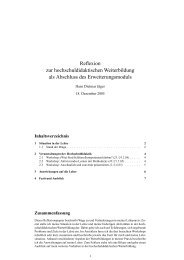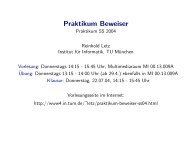Information Flow Security for Imperative Languages
Information Flow Security for Imperative Languages
Information Flow Security for Imperative Languages
You also want an ePaper? Increase the reach of your titles
YUMPU automatically turns print PDFs into web optimized ePapers that Google loves.
<strong>In<strong>for</strong>mation</strong> <strong>Flow</strong> <strong>Security</strong><br />
<strong>for</strong> <strong>Imperative</strong> <strong>Languages</strong><br />
Robert Grabowski<br />
Institut für In<strong>for</strong>matik, Universität München<br />
Oettingenstraße 67, 80538 München<br />
robert.grabowski@ifi.lmu.de<br />
Abstract. <strong>In<strong>for</strong>mation</strong> flow analyses are a way to ensure that a computer<br />
system does not release confidential data to the public. This paper<br />
presents a language-based notion of in<strong>for</strong>mation flow security known as<br />
non-interference, and shows how to prove the property with a type system.<br />
Furthermore, practical challenges arising in flow-secure software<br />
development are outlined.<br />
1 Introduction<br />
An important problem of computer security is protecting confidentiality of in<strong>for</strong>mation<br />
manipulated by computing systems. A widely used solution is access<br />
control, where the release of confidential in<strong>for</strong>mation requires a certain privilege<br />
to access that in<strong>for</strong>mation. However, there are certain situations where access<br />
control is too inflexible and restricted.<br />
Consider, <strong>for</strong> example, an application that manages a local address book containing<br />
private in<strong>for</strong>mation. The software regularly needs to access an Internet<br />
server to retrieve automatic security updates. By error or malice, the software<br />
could also transfer the contents of the address book to that server. Using access<br />
control, such a behaviour cannot be prevented without prohibiting access to either<br />
the address book or the server completely. A better approach is to control<br />
the flow of in<strong>for</strong>mation after it has been released from its container.<br />
2 Policies <strong>for</strong> <strong>In<strong>for</strong>mation</strong> <strong>Flow</strong>s<br />
A system is in<strong>for</strong>mation-flow secure if an outside attacker cannot obtain knowledge<br />
about internal secret data by interacting with the system. In the following,<br />
we focus on language-based in<strong>for</strong>mation flow security, although there also exist<br />
concreter notions e.g. <strong>for</strong> automata-based models of computing systems.<br />
We assume that data items like variables or files associated with security<br />
domains like “private” and “public”. An in<strong>for</strong>mation flow policy describes valid<br />
flows between objects of the respective domains, <strong>for</strong> example “in<strong>for</strong>mation may<br />
flow from public to private objects, but not vice versa”.<br />
We model a policy as a lattice (D, ⊑, ⊔, ⊓), where D is the set of domains,<br />
⊑ is a partial order on the domains (the flow relation), and ⊔ and ⊓ are the
least upper bound and greatest lower bound. The relation ⊑ is reflexive, since<br />
data may flow freely within a domain. Transitivity of ⊑ ensures that we will<br />
not allow an indirect flow over several domains wihtout allowing a direct flow.<br />
Since policies consisting of multiple domains can be expressed as a conjunction<br />
of policies with two domains, we restrict D to the two domains low and high,<br />
with low ⊑ high and high ⋢ low. Data may thus flow from low to high, but not<br />
vice versa.<br />
2.1 An <strong>Imperative</strong> Language<br />
In the following, we consider a simple imperative language consisting of an<br />
empty command, a variable assignment, sequential composition, while-loops and<br />
branching statements. The abstract syntax is defined as follows:<br />
e ∈ Expr ::= x | v | e op e<br />
C ∈ Com ::= skip | x := e | C ; C | while e do C<br />
| if e then C else C<br />
The language is defined over a set X of variables (ranged over by x), a set V<br />
of values (ranged over by v), and one or more operations op on expressions. 1<br />
A program state σ ∈ X → V is a mapping of variables to values. The operational<br />
semantics of a program C is given by the standard big-step relation<br />
σ C −→ τ. It relies on a function . σ<br />
<strong>for</strong> evaluating expressions in state σ.<br />
2.2 Variables and Domains<br />
We statically relate each variable x ∈ X with either the low or the high domain,<br />
depending on the confidentiality of its contents, thereby splitting the set<br />
of variables X into two disjoint sets X low and X high .<br />
Example As an intuitive example <strong>for</strong> an insecure program, we assume X contains<br />
two variables l and h with l ∈ X low and h ∈ X high . The program<br />
l := h<br />
violates the policy high ⋢ low, since in<strong>for</strong>mation is transferred from a high<br />
variable to a low variable.<br />
2.3 Covert Channels<br />
Apart from direct in<strong>for</strong>mation transfer via assignments, there are a number of<br />
less obvious methods <strong>for</strong> signalling secret in<strong>for</strong>mation to a public channel, as<br />
demonstrated by the examples in figure 1.<br />
1 In our examples, we will mainly use integer and boolean values and assume the<br />
language provides standard arithmetic and comparison operations, like plus or less.
if h >= 0 then l := 1 else l := 3 (1)<br />
l := 0 ; while l < h do l := l + 1 (2)<br />
while h >= 0 do skip (3)<br />
while h > 0 do h := h − 1 (4)<br />
Fig. 1. Examples <strong>for</strong> covert flows<br />
– Implicit flows arise through control structures. If the execution path depends<br />
on secret data and if that path is observable (e.g. when public variables<br />
are changed), an attacker might get in<strong>for</strong>mation about the secret data. In<br />
example 1, the different assignments implicitly convey in<strong>for</strong>mation about<br />
the value of h. The same holds in example 2 <strong>for</strong> the assignment within the<br />
while loop (the program is actually equivalent to l := h if h is positive). In<br />
general, implicit flows are caused by assigning to low variables under a high<br />
branching condition.<br />
– The termination behaviour might signal secret in<strong>for</strong>mation. Example program<br />
3 terminates only if h is negative. A more general <strong>for</strong>m is timing behaviour:<br />
The time at which an action occurs (e.g. termination) might also<br />
leak in<strong>for</strong>mation. In example 4, the length of the run depends on the initial<br />
value of h.<br />
– Other channels include changes of the probability distribution of secret values,<br />
or external resources usage that depends on secret values.<br />
In this paper, we only consider implicit flows. In particular, our security<br />
notion only includes terminating programs.<br />
3 Non-Interference<br />
A standard <strong>for</strong>malisation of in<strong>for</strong>mation flow security is non-interference. This<br />
end-to-end security property abstracts away from language and execution details<br />
and gives a requirement on the program states be<strong>for</strong>e and after the execution.<br />
A program is non-interferent if changing the intial values of high variables does<br />
not affect the final value of any low variable. This is captured more <strong>for</strong>mally by<br />
the following definition:<br />
Definition 1 (Non-interference). Two states σ, σ ′ are indistinguishable with<br />
respect to low variables, written σ ∼ σ ′ , if σ(x) = σ ′ (x) <strong>for</strong> all x ∈ X low .<br />
A program C is secure if whenever σ ∼ σ ′ and σ C −→ τ and σ ′ C<br />
−→ τ ′ then τ ∼ τ ′ .<br />
Two runs of the programs on initial states that only differ on high variables<br />
must result in two final states that also only differ on high variables. In other<br />
terms, <strong>for</strong> an observer who only sees the low parts of the initial and final states,<br />
the program behaviour must be deterministic.
<strong>Security</strong> levels: i ::= low | high<br />
Variables: h ∈ X high , l ∈ X low<br />
T-Var-H ⊢ h : high<br />
T-Var-L ⊢ l : low<br />
T-Const ⊢ v : low<br />
T-Op ⊢ e1 : i ⊢ e2 : i<br />
⊢ e 1 op e 2 : i<br />
T-Expr-Sub ⊢ e : low<br />
⊢ e : high<br />
T-Skip [high] ⊢ skip<br />
T-Assign-H [high] ⊢ h := e<br />
T-Assign-L ⊢ e : low<br />
[low] ⊢ l := e<br />
T-Comp<br />
[i] ⊢ C1 [i] ⊢ C2<br />
[i] ⊢ C 1 ; C 2<br />
T-While<br />
⊢ e : i [i] ⊢ C<br />
[i] ⊢ while e do C<br />
T-If<br />
⊢ e : i [i] ⊢ C1 [i] ⊢ C2<br />
[i] ⊢ if b then C 1 else C 2<br />
T-Com-Sub [high] ⊢ C<br />
[low] ⊢ C<br />
Fig. 2. Volpano-Smith-Irvine Type System<br />
Example The introductory example l := h is insecure since there are states <strong>for</strong><br />
which the non-interference property does not hold. Consider the initial states<br />
σ = {l ↦→ 3, h ↦→ 4} and σ ′ = {l ↦→ 3, h ↦→ 8}. Since the value of l is equal<br />
in both states, we have σ ∼ σ ′ . After l := h, the value of l is different in the<br />
resulting states τ and τ ′ , hence τ ≁ τ ′ .<br />
In fact, any assignment of the <strong>for</strong>m l := e is insecure if the evaluation of e<br />
depends on the value of h, like l := h + 4 or l := l ∗ h, but not l := h − h.<br />
4 Static <strong>In<strong>for</strong>mation</strong> <strong>Flow</strong> Analysis<br />
Non-interference can be proven statically using the type system by Volpano,<br />
Smith, and Irvine [1], shown in figure 2.<br />
The first five rules define inductively a typing judgement ⊢ e : i <strong>for</strong> expressions,<br />
stating that e is either public (i = low) or confidential (i = high). Any<br />
low expression may also serve as a high expression (rule T-Expr-Sub). Since<br />
the rules are syntax-directed, an expression can only be typed low if it does not<br />
contain a variable from X high . There<strong>for</strong>e, a low expression always evaluates to<br />
the same value in indistinguishable states:<br />
Theorem 1 (Soundness of expression typing). Let e be an expression. If<br />
⊢ e : low then σ ∼ σ ′ ⇒ e σ<br />
= e σ ′.<br />
The remaining rules define a typing judgement [i] ⊢ C <strong>for</strong> programs. The<br />
rule T-Assign-L prevents direct insecure in<strong>for</strong>mation flows, since low typed<br />
variables may only receive values of low typed expressions. The domain i in<br />
program typing judgements indicates that all variables updated by the program<br />
have at least type i. This in<strong>for</strong>mation is used in the T-If and T-While rules<br />
to prevent implicit flows: a branching on a high expression is well-typed only<br />
if all subprograms are [high] typable, i.e. if they do not update low variables.
The subsumption rule T-Com-Sub relaxes the strong assertion derived with a<br />
[high] type judgement, and is needed <strong>for</strong> adjusting the types of subprograms <strong>for</strong><br />
T-Comp, T-If or T-While.<br />
Theorem 2 (Soundness of program typing). Let C be a program. If the<br />
typing judgement [low] ⊢ C can be derived, then C is secure, i.e. non-interference<br />
holds.<br />
The type system is not complete, since it also rejects many secure programs.<br />
For example, the program<br />
l := h ; l := 0<br />
is secure despite of the suspicious first assignment, since the final value of l does<br />
not depend on the initial value of h. The flow-sensitive type system by Hunt<br />
and Sands [2] accounts <strong>for</strong> these situations, since it allows the type of a variable<br />
to “float” during the execution of a program. The first assignment would then<br />
update the type of the variable l to high. The second assignment would set it<br />
back to low, since the secret data it temporarily contained is overwritten by a<br />
constant. Other programs are more difficult to prove secure and require a more<br />
thorough analysis.<br />
5 Practical issues<br />
5.1 External Data<br />
To demonstrate some of the challenges secure flow analysis faces in practice, we<br />
consider a simple file append programm. The program retrieves two file names,<br />
opens the associated files, and appends the contents of the first file to the contents<br />
of the second file. We assume that each file is typed either high or low, depending<br />
on the confidentiality of its contents. The secure flow requirement we would like<br />
to en<strong>for</strong>ce is that a high file may not be appended to a low file, since that would<br />
publish private data.<br />
To state the non-interference property <strong>for</strong>mally, we need to model external<br />
data like the file system within the program semantics. A solution is to treat<br />
file names and file handles as references to arbitrary data, and to assume given<br />
functions <strong>for</strong> opening, reading and writing those files. One there<strong>for</strong>e needs to<br />
adapt the type system to a language with references, and give a soundness proof.<br />
Instead, one could also use e.g. the in<strong>for</strong>mation flow analysis <strong>for</strong> object-oriented<br />
language given by Banerjee and Naumann [3].<br />
Another approach is taken by JIF [4], an extension to the Java language that<br />
allows annotating variables, fields and methods with labes, which are similar to<br />
domains. While labels are usually declared statically, the JIF runtime features a<br />
Java-equivalent OpenFile method which returns a file handle annotated with a<br />
dynamic label, reflecting the confidentiality of the actually opened file at runtime.<br />
There<strong>for</strong>e, a JIF implementation of ’append’ cannot be statically verified by the<br />
compiler.
JIF is the only existing implementation of a secure in<strong>for</strong>mation flow language<br />
and compiler to date. Nevertheless, it should be noted that there is no soundness<br />
result <strong>for</strong> its type system, and even <strong>for</strong> fully statically typable programs, no<br />
satisfying end-to-end security assertion can be given.<br />
5.2 Towards a Secure <strong>Flow</strong> Framework<br />
An open research topic is the integration of secure in<strong>for</strong>mation flow concepts in<br />
the specification phase of a software. This could be done by extending the UML<br />
language to allow <strong>for</strong> defining flow policies, and to show how these security<br />
requirements are translated to the language level, possibly by using results from<br />
the field of automata-based non-interference.<br />
Furthermore, a promising idea is to embed the analysis into a proof-carrying<br />
code architecture <strong>for</strong> safely executing a program e.g. on a mobile device. The<br />
proof that a program is secure is then and distributed as a certificate together<br />
with the code, such that the proof can be verified automatically by the device<br />
against its security policy. Both the secure flow specification and certification<br />
are main goals of the InfoZert project [5].<br />
6 Summary<br />
Secure in<strong>for</strong>mation flows are an interesting challenge in the field of computer<br />
security and program analysis. This paper showed how in<strong>for</strong>mation flow policies<br />
can be interpreted as a non-interference property, and how this property can<br />
be proven with a type system. A more detailed overview of different notions<br />
of in<strong>for</strong>mation flow security and analysis methods can be found in a survey by<br />
Sabelfeld and Myers [6].<br />
Furthermore, the are a number of practical issues with integrating the notion<br />
of secure flows into real-world programs, and open work remains <strong>for</strong> the design<br />
and implementation of a larger in<strong>for</strong>mation flow security framework.<br />
References<br />
1. Volpano, D., Smith, G., Irvine, C.: A sound type system <strong>for</strong> secure flow analysis.<br />
J. Computer <strong>Security</strong> 4(3) (1996) 167–187<br />
2. Hunt, S., Sands, D.: On flow-sensitive security types. In Morrisett, J.G., Jones,<br />
S.L.P., eds.: Proceedings of the 33rd ACM Symposium on Principles of Programming<br />
<strong>Languages</strong> (POPL 2006), ACM Press (2006) 79–90<br />
3. Banerjee, A., Naumann, D.: Stack-based access control and secure in<strong>for</strong>mation flow<br />
(2003)<br />
4. Myers, A.C.: Jflow: Practical mostly-static in<strong>for</strong>mation flow control. In: POPL.<br />
(1999) 228–241<br />
5. Beringer, L., Grabowski, R., Hofmann, M., Knapp, A., Lasinger, F., von Oheimb, D.:<br />
The infozert project. http://www.pst.ifi.lmu.de/Research/current-projects/infozert<br />
6. Sabelfeld, A., Myers, A.C.: Language-based in<strong>for</strong>mation-flow security. IEEE Journal<br />
on Selected Areas in Communications – special issue on Formal Methods <strong>for</strong> <strong>Security</strong><br />
21(1) (January 2003) 5 – 19



